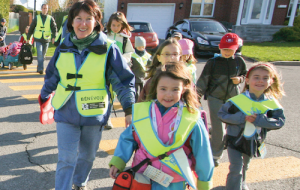La Société canadienne du cancer, dans le cadre de ses activités en prévention et en promotion de la santé, propose aux écoles primaires de jumeler activité physique, plaisir et sécurité avec le programme d’autobus pédestres Trottibus.
Par Véronique Alain, Société canadienne du cancer
Les récentes données sur la santé des jeunes sont peu reluisantes : augmentation constante de l’obésité, diminution importante de l’activité physique quotidienne. Ainsi, selon le rapport Les jeunes et l’activité physique : Situation préoccupante ou alarmante? de Kino-Québec, « les jeunes d’aujourd’hui, comparativement à ceux d’il y a trente ans, sont 40 % moins actifs et l’obésité juvénile a augmenté de 50 % »
Depuis maintenant 40 ans, l’habitude de marcher sur le chemin de l’école s’est perdue

Inspiré d’initiatives semblables au Canada et ailleurs dans le monde, le Trottibus permet à l’élève du primaire de marcher de la maison vers l’école de façon sécuritaire et amusante. Au moyen d’horaires, de trajets et d’arrêts prédéterminés, des adultes bénévoles, nommés « Grands-trotteurs », accompagnent les enfants à l’école.
Comme le témoigne la vidéo du projet Trottibus, ce sont maintenant des centaines d’enfants au Québec qui parcourent, beau temps mauvais temps, les rues de leur quartier pour se rendre à l’école.
Le transport actif, en plus d’augmenter l’activité physique au quotidien, favorise l’autonomie des jeunes et la socialisation, deux éléments qui contribuent à la réussite scolaire. Il fait d’ailleurs partie des cinq recommandations données au MELS par un groupe d’experts en activité physique.
Alors à quand votre premier voyage à bord du Trottibus?





 Recevez l'Info #DevProf et l'Hebdo pour ne rien manquer des nouveautés de l'École branchée!
Recevez l'Info #DevProf et l'Hebdo pour ne rien manquer des nouveautés de l'École branchée!




